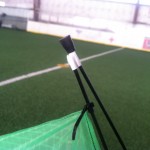This year, I spent the month of July in Singapore doing school performances for ACT 3 International. During my stay, I had the pleasure of meeting the man behind the Plutz and the Zero-G, Leong Chee Wan of Malaysia. Chee Wan had a new toy to show off when we met, aptly named the BiPlutz. The kite is essentially a plutz with the large bottom portion of the kite duplicated to replace the skinnier portion on the top of the kite. This new design makes some interesting changes to the way the kite flies. For this review, I am going to look at a few particular characteristics that should be looked at when judging any indoor glider: style, glide, lift, relaunch, and durability.
Style
This BiPlutz is another product from Chee Wan that really only fits in his own “Pluz” category of gliders. It is certainly not a zero-g kind of glider like the iFlite or Zen glider, and it does not have a kind of build to be compared to the Skate or Wala.
The kite is an interesting build with carbon bent under tension, and suspended fabric. Assembly is a bit more complicated than some more traditional gliders, but after you have done it once, it falls into place pretty easily.
The BiPlutz has some unique traits to it that I have not found in any other indoor gliders. One of my favorites is that it can work a bit like a Rokkaku in that with the right amount of tension, the kite can hover in altitude. A flier can even use this to send out a lot of line without lifting the kite more than a foot off of the ground.
Glide
The glide characteristic of an indoor glider refers to how the kite flies without line tension. A glide is usually initiated by an up-and-over when giving slack to the line after reaching the apex of the up-and-over.
The glide of the BiPlutz comes closest in comparison to the Wala. If you get it right, and keep just the right amount of slack in the line, then the glide can be flawless. If you don’t get it right, however, the BiPlutz makes an odd hump. Most gliders, when the glide is not perfect, the kite will dip down, then curve up, then dip down again and repeat. The BiPlutz does this, but instead of just dipping down, the kite will fly backwards for a moment first. If you don’t see it coming, you may end up with an extra meter or so of slackline at a moment’s notice. This characteristic does offer some interesting prospects for catches and the like though. It may be interesting to see what fliers may do to utilize this.
The kite has an adjustable bridle in the center that changes some flight characteristics of the kite. When the setting is pulled all the way forward, the kite flies with a bit more lift, but is more prone to stalling in the glide. As it is pulled toward the back, it has the inverse effect. I found that with the bridle pulled a decent way toward the back, the kite keeps more of a downward pitched glide, meaning that it reaches the ground faster. Because of this, I tend to keep the bridle attached at the first half centimeter or so.
Lift
Lift, as I will be using it, refers to the kite’s ability to gain altitude. If there is one thing that the BiPlutz is good at, it is lifting. With the two large sails, the kite is able to gain altitude with relative ease. I have a small winder that has some unknown length of line on it for gliders. This is the only kite that I have flown and been able to fully extend the length of my line.
Between this kite’s glide, hover, and lift, getting some altitude out of the kite is not too difficult.
Relaunch
One important aspect of an indoor glider is how well you can recover from the kite landing on the ground. The BiPlutz is very unique in this aspect. The kite never gets into a dead launch, where there is no recovery without physically picking the kite up. However, when it launches from the ground, it tends to launch sideways. This can be a problem if you are flying in a crowded area with many obstacles, but not too bad for indoor festival antics.
Durability.
 The kite is built with what looks like pultruded carbon. The sail of the one I have worked with is ripstop polyester, but will also be available in silicone coated ripstop nylon.
The kite is built with what looks like pultruded carbon. The sail of the one I have worked with is ripstop polyester, but will also be available in silicone coated ripstop nylon.
When taken down and rolled up, the kite is just able to fit into my Revolution roll-up bag. It is near the length of a rolled-up Revolution 1.
I have been flying this kite since July, and I have only noticed one durability issue. On the nose of the kite, there are two rods that come together. The connection appears to be made with a vinyl tube with a slit on the side so that it splits and holds two rods. I have noticed the edges of this slit have begun to travel, and I fear that this connection may break at some point. For now, I have wrapped this bit with a small amount of duct tape, and it seems to do ok.
All in all, I am really enjoying this kite. It looks great and it flies great. It has been staying in my bag, and I think it will for a while.
Until next time,
Watty









